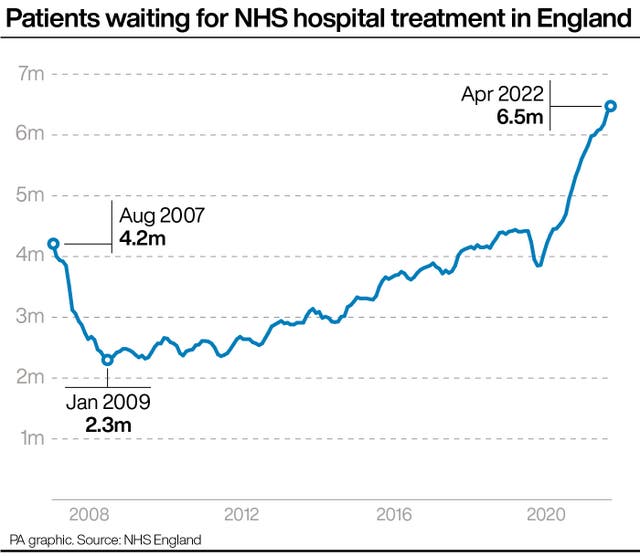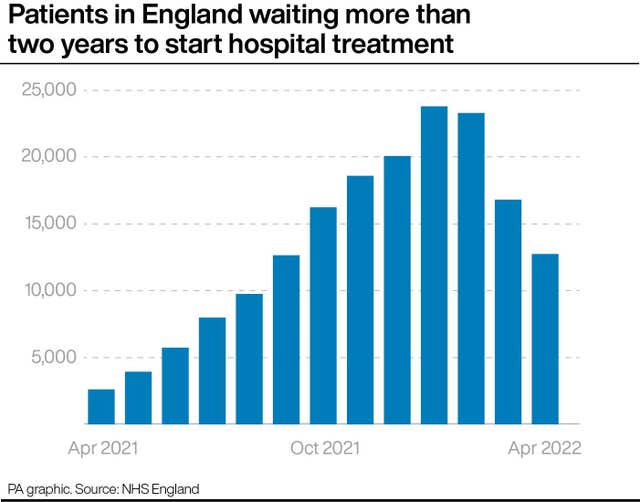
The number of people waiting longer than two years for NHS treatment has fallen sharply, though the overall waiting list is still rising, figures show.
New data from NHS England shows that two-year waits for treatment almost halved in a three-month period.
Some 12,735 people were waiting more than two years for hospital treatment at the end of April, down from 23,778 in January 2022 (the all-time high).
However, the latest figure is nearly five times the 2,608 people who were waiting longer than two years in April 2021.

The Government has set the ambition to eliminate all waits of more than two years, except when it is the patient’s choice, by July of this year.
The data also showed 323,093 people had been waiting at least a year for treatment in April, up from 306,286 the previous month.
The Government has set the ambition of eliminating all waits of more than a year by March 2025.
Meanwhile, the number of people in England waiting to start routine hospital treatment has risen to a new record high.
A total of 6.5 million people were waiting to start treatment at the end of April, up from 6.4 million in March. It is the highest number since records began in August 2007.
Tim Mitchell, consultant, ear, nose and throat surgeon and vice president of the Royal College of Surgeons of England, said: “Today’s figures show light at the end of the tunnel for people who have been waiting excessively long for a planned hospital treatment.
“Surgical teams have been working around the clock to reduce the enormous waiting list which built up during the pandemic.
“However, there are still big challenges ahead. As people return to the NHS, demand is only getting stronger.”
Thursday’s data further shows 204,818 urgent cancer referrals were made by GPs in England in April.
This is down from a record 253,796 referrals in March, but is higher than the equivalent figures for April 2020 at the start of the Covid-19 pandemic (80,031) and for the non-pandemic month of April 2019 (199,217).

The proportion of patients in England seeing a specialist within two weeks in April was 79%, down from 81% in March, while 71% of patients urgently referred for suspected cancer were diagnosed or had cancer ruled out within 28 days, down from 73% the previous month.
Some 439,306 patients in April were also waiting longer than six weeks for one of 15 standard diagnostic tests, including an MRI scan, non-obstetric ultrasound or gastroscopy.
Elsewhere, the the average response times in May for ambulances in England have improved slightly.
For the most urgent incidents, defined as calls from people with life-threatening illnesses or injuries, the overall response time was eight minutes and 36 seconds.
This is down from nine minutes and two seconds in April, but is still above the target standard of seven minutes.
Ambulances in England also took an average of 39 minutes and 58 seconds last month to respond to emergency calls such as burns, epilepsy and strokes.
This is down from 51 minutes and 22 seconds in April, but above the target of 18 minutes.
Professor Sir Stephen Powis, national medical director for NHS England, said: “The new figures show our hard-working NHS staff are making significant progress in ensuring people waiting the longest time for care are getting treated.
“There is no doubt the NHS still faces pressures – including a renewed increase in Covid patients – and the latest figures show just how important community and social care are in helping people in hospital leave when they are fit to do so, not just because it is better for patients but because it helps free up precious NHS bed space.”
Nuffield Trust deputy director of research, Dr Sarah Scobie, said: “The health secretary yesterday claimed the pandemic was the root cause of the A&E crisis, but the Government can not hide solely behind Covid-19.
“In May, 40% of patients attending major A&E departments waited over four hours to be admitted, transferred or discharged. But in reality, this key target has not been met since July 2015, and the root causes can be traced back to over a decade ago.
“While the pandemic has made the situation worse, we are reaping the rewards of a long-term squeeze on staffing and space.
“The new normal and the long waits illustrated by these figures go far beyond an inconvenience and put patients at considerable risk.”

Siva Anandaciva, chief analyst at the King’s Fund said that while some ambulance service response times have improved compared to the previous month, patients are still waiting too long.
“These increasingly commonplace long waits for emergency care are not just frustrating; they are potentially dangerous.
“Long waits for care and delayed discharges from hospitals were a concern long before Covid.”


Comments: Our rules
We want our comments to be a lively and valuable part of our community - a place where readers can debate and engage with the most important local issues. The ability to comment on our stories is a privilege, not a right, however, and that privilege may be withdrawn if it is abused or misused.
Please report any comments that break our rules.
Read the rules hereLast Updated:
Report this comment Cancel